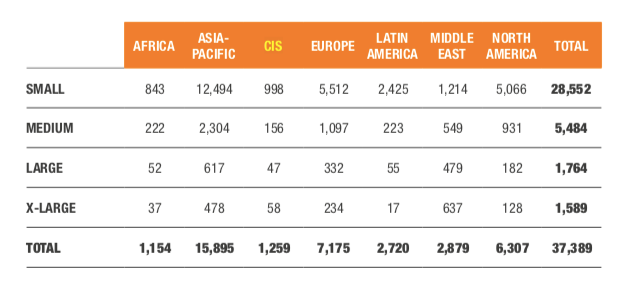Summary:
- Airbus is projecting a nearly doubling of the fleet in Russia and the CIS over the next 20 years;
- There are currently 857 aircraft with least 100 seats in service in Russia and the CIS;
- Airbus expects over 1,200 aircraft will be delivered over the next 20 years - a relatively even mix of replacements and growth;
- With the new long range narrowbodies, the region has potential for more hub operations.
The manufacturer projects passenger traffic in Russia and the CIS will grow at an average rate of +4.1% per year over the next two decades. This is slightly slower than the projected +4.4% per year global average passenger growth rate.
Russia currently has in-service fleet of 1,141 commercial aircraft and 428 aircraft on order, according to the CAPA - Centre for Aviation Fleet Database. The other 11 countries combined have an in-service fleet of 538 commercial aircraft and an order book of only 70 aircraft. Most airlines from these countries rely on second hand aircraft to renew and expand their fleets.
The 1,679 aircraft in the CAPA Fleet Database for the 12 original CIS countries includes all commercial aircraft types (passenger and freighters) and all manufacturers. Airbus only includes aircraft with over 100 seats and freighters of at least 10 tonnes in its GMF.
When only including Airbus and Boeing aircraft, the CAPA database lists 629 in-service aircraft for Russia (317 Airbus and 312 Boeing). For the other 11 countries combined the in-service fleet is 250 aircraft (60 Airbus and 190 Boeing).
CAPA includes five of these countries under the Central Asia region: Kazakhstan, Kyrgyzstan, Tajikistan, Turkmenistan and Uzbekistan. Central Asia currently has a fleet of 199 in-service aircraft and 35 on order. The other seven countries that are under Airbus' CIS definition come under CAPA's Eastern/Central Europe region.
Single aisle aircraft dominate the current fleet in the CIS and are expected to account for most of the new aircraft over the next 20 years. This is hardly surprising given that most traffic consists of passengers travelling within the region (domestic or regional international).
New narrowbodies offer a hub role for the region
The CIS is also geographically well positioned for medium/long-haul narrowbody operations, particularly as new generation narrowbodies are delivered. The CIS is at the crossroads of Europe and Asia and therefore a large part of Asia is within narrowbody range along with virtually all of Europe. Parts of the Middle East and Africa can also be served with narrowbodies.
Of the 1,221 new passenger aircraft projected by Airbus for Russia and the CIS, 998 are aircraft in its "small" segment (encompassing the A220 and A320 families). The remaining 223 aircraft include 140 "medium" aircraft (generally small widebodies), 39 "large" aircraft and 44 "extra large" aircraft. Airbus also projects 38 new freighter aircraft (16 medium, eight large and 14 extra large) for Russia and the CIS along with 33 passenger-to-freighter conversions.
The new forecast represents a slight acceleration from Airbus' previous forecast, which projected 1,182 passenger aircraft deliveries for Russia and the CIS from 2017 to 2036. The previous forecast included 1,009 new small aircraft, 120 small widebody aircraft and 53 large widebody aircraft and projected only 21 freighters.
The CIS is a relatively small but increasing important region to manufacturers as airlines seek to replace ageing fleets and accelerate growth in response to surging demand.
CHART - New passenger and freight aircraft deliveries by region: 2018 to 2037 Source: Airbus Global Market Forecast 2018 (NOTE: only includes passenger aircraft with over 100 seats and freighters of at least 10tonnes
Source: Airbus Global Market Forecast 2018 (NOTE: only includes passenger aircraft with over 100 seats and freighters of at least 10tonnes
Airbus includes 12 countries under its Russia and CIS definition. Russia dominates as the 11 other countries are relatively small and spread across the fringes of Eastern Europe and Central Asia - Armenia, Azerbaijan, Belarus, Georgia, Kazakhstan, Kyrgyzstan, Moldova, Tajikistan, Turkmenistan, Ukraine and Uzbekistan. Georgia actually withdrew from the CIS in 2009 and Ukraine earlier this year, leaving 10 members of the Commonwealth of Independent States, but Airbus continues to include all 12 original members.